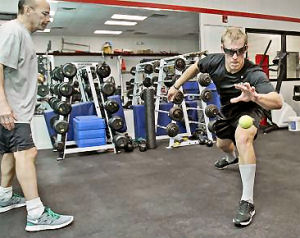16 December 2013
Athletes show significant performance boost from stroboscopic glasses
by Will Parker
 Professional hockey players who trained with special eyewear that only allowed them to see the action intermittently recorded an 18 percent improvement in on-ice skills. The players, from the NHL's Carolina Hurricanes, were part of a Duke University study that is reported in this month's edition of Athletic Training & Sports Health Care.
Professional hockey players who trained with special eyewear that only allowed them to see the action intermittently recorded an 18 percent improvement in on-ice skills. The players, from the NHL's Carolina Hurricanes, were part of a Duke University study that is reported in this month's edition of Athletic Training & Sports Health Care.
The special eyewear features lenses that switch between transparent and opaque, producing stroboscopic visual conditions, much like a strobe light in a dance club.
Preliminary research using stroboscopic eyewear during training showed improvements in vision, visual attention, and ability to anticipate the timing of moving items. But the new study with the Hurricanes players is the first to explore whether those effects can directly improve performance on the ice.
"From a sports perspective, you want to know if something is going to be an actual, viable training tool," said lead researcher Stephen Mitroff. "If players train with it, will they likely get the benefits? Our previous work showed that stroboscopic training affected vision and attention, and here we explored if those changes can benefit sports performance."
In the new study, the players were randomly divided into a five-player control group that completed normal training and a six-player strobe group that wore the eyewear during normal training. Each group completed a performance assessment before and after training. Forwards were asked to perform a task that involved difficult skating before taking shots on goal, and defensemen were asked to skate in a circle before completing long passes.
During training, the eyewear's lenses alternated at different rates, always with a clear state for a tenth of a second, and various opaque states ranging in intervals from 67 milliseconds to nine-tenths of a second.
Mitroff claims the players who trained with the strobe eyewear experienced an 18 percent performance improvement in a series of on-ice skill tests. The control group showed no change. "That 18-percent improvement for on-ice skills for professional players is huge," he said. "This is a dramatic improvement observed in professional athletes."
He does caution, however, that the results are preliminary because of the small size of the study and that more research is needed to determine the true impact of the eyewear on performance. Although the most immediate application of the strobe eyewear is in athletics, Mitroff says the potential does exist for it to have an impact in medical, military, and physical rehabilitation settings.
Related:
Discuss this article in our forum
Oscar Pistorius' artificial limbs provide "major advantage for sprinting"
The color red provides speed and strength boost
Lactic Acid Not The Culprit In Muscle Fatigue
Up, Up And Away For Athletes Taking Viagra
Source: Duke University
